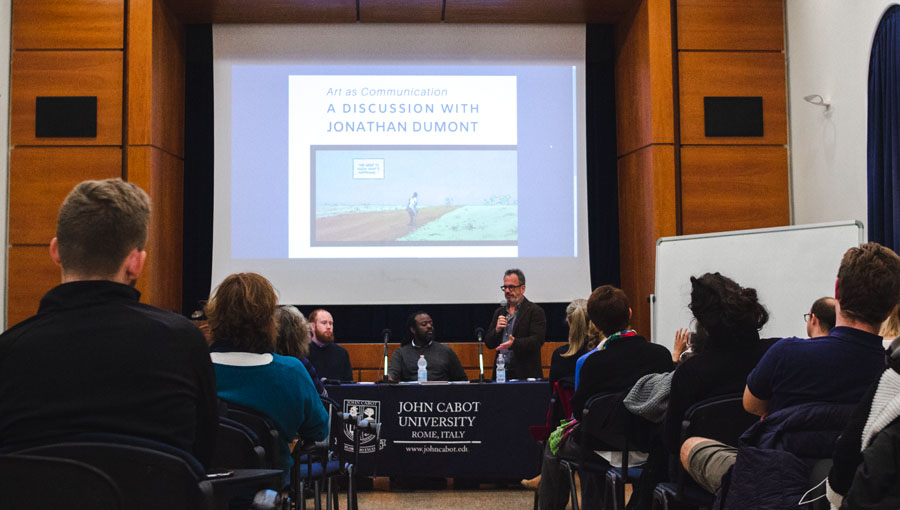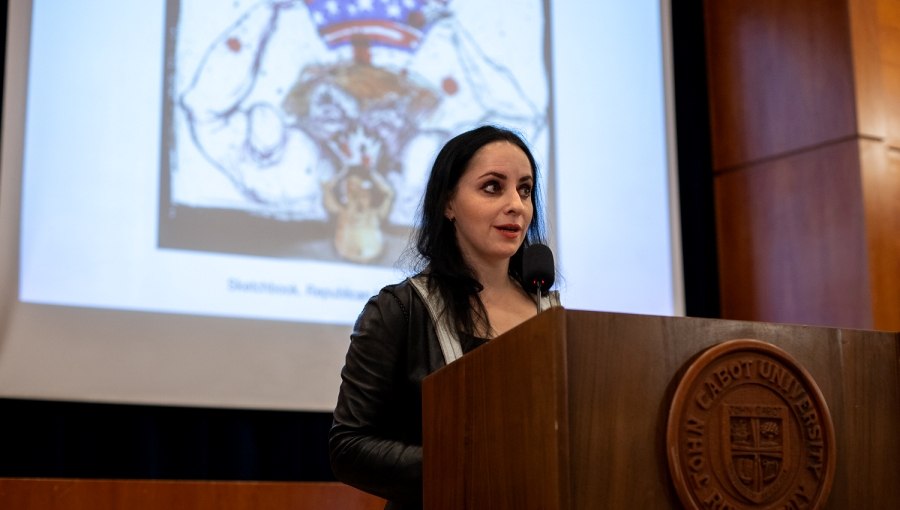Art as Communication: JCU Welcomes Jonathan Dumont of World Food Programme
The John Cabot University Department of Art History and the Department of Communications welcomed Jonathan Dumont, Head of Television Communications at the United Nations World Food Programme (WFP), for a lecture on Art as Communication on December 2, 2019. The event was conceived by Dr. Cornelia Lauf, who teaches in the MA in Art History program. Nathaniel Sloan and Matthew Beckmann, degree candidates in the program who collaborated with Dr. Lauf, acted as moderator and coordinator respectively.
Jonathan Dumont presented his recent project for the WFP, which is a series of graphic novels depicting the situation in countries suffering war and famine. The series was written by Dumont and Joshua Dysart, with art by Alberto Ponticelli and Pat Masioni. The project’s title, LIVING LEVEL-3, refers to the most severe level of humanitarian emergency in the world.
Art as Communication focused on the communicative power, artistic potency, and narrativity of the graphic novel and documentary film. The central question to the discussion was how the power of visual storytelling can be an effective communication tool in emergency situations.
JCU Communications Professor Kwame Phillips, anthropologist and filmmaker, participated in the conversation. Professor Phillips specializes in visual media production, as well as ethnographic documentary and soundscapes. Some of his recent projects include Welcome to Pa Pae, a documentary film that paints an intimate picture of daily life in a remote hill tribe community in Northern Thailand.
The discussion was preceded by a screening of the animated film “Living Level 3 — Iraq,” which is WFP’s latest project, overseen by Dumont. The film focuses on the story of Leila, a humanitarian worker who was deployed to Iraq in the summer of 2014 when the so-called Islamic State (IS) militants took over the city of Mosul. The film is based on Dumont’s graphic novel by the same title.
The making of the film
“The fundamental part of the film is the idea of telling a story,” Dumont said as he started recalling the process of making the film. He explained that first, actual video footage was transformed into a graphic novel and then animated for the purpose of the film. Both the graphic novel and the film depict true stories, although “some scenes were added, to show the whole story.” The stories are represented accurately and truthfully, as Dumont highlighted, yet the project included several creative decisions that would not have been possible in a documentary. For instance, the faces of ISIS fighters in the film are replaced by black doodles. “Showing someone’s face confers dignity and respect to a person. Therefore, the ISIS fighters do not have faces in our film,” explained Dumont. He said that during the making of the film and the graphic novel the biggest challenge was staying factual and truthful to the story.
Telling a powerful story is important because in the media, as Dumont added, “you compete with Trump or Brexit.” Both Dumont and Professor Phillips highlighted that the current competition in media is based on violence and eye-catching content. Stories have to be told in a dramatic manner so that they can be seen and heard. At the same time, Dumont said that making the story powerful has its limits, since “if we tell something that would be too controversial, we won’t be able to go back to those places, and people will die because we won’t bring them the help they need.”
Documentary as a message
In raising awareness, documentary has the advantage of “making the unfamiliar familiar,” said Professor Phillips. “Documentary films have the ability and desire to put the viewer in the space,” he added. Documentary as a genre has developed in many different ways particularly in the last few years. Recently, there has been a shift in strategy based on the narrative. “What has especially changed for the documentary has been a so-called ‘aesthetic turn,’ a movement towards making films that are more artistic, which is particularly visible in the ethnographic field,” explained Professor Phillips. Consequently, there is a struggle and discussion about where art is supposed to fit in documentary and ethnographic films. According to Professor Phillips, there should be no line between the art and the document. He added that the artistic approach is often more truthful and more likely to trigger feelings of compassion than the delivery of sole facts.
Representation or exploitation? Dealing with real people and real stories
Both Dumont and Professor Phillips talked about the ethical responsibility of telling other people’s stories.
Professor Phillips shared his experience and approach regarding ethnography. He said that he contacts organizations or people beforehand so that he can learn what would be most useful for them. What is most important, emphasized Professor Phillips, is “communicating with the people you are collaborating with and making sure it is their voice that is heard and not yours.”
Dumont said that he feels a great responsibility each time he has to share someone’s story. “People want their story told because the stories are their realities and they want the world to know,” he explained. Often, in the Level-3 countries, those who tell the stories know that people like Dumont have access to places and institutions they are not able to reach. Having their stories told provides them with relief, but it also constitutes a chance for hope and help. “My responsibility is to make the best out of this story,” he added.
The impact of the shared story
Dumont said that making the story heard can influence both decision-makers and ordinary people to create public pressure and influence politicians. “At the UN, we believe that if we get a story shown in an attempt to influence politicians, in turn, they will respond with help.” However, Dumont admitted that often politicians are aware of the stories and situations in Level-3 countries. What Dumont highlighted is that usually when there is a humanitarian crisis the general public is not aware of it and of the stories behind it, but “that’s what we are trying to change.”
Sharing stories and raising awareness are small steps that should be taken, said Professor Phillips. As awareness grows, public pressure will hopefully influence politicians and larger steps will be taken, bringing more help and change to the situations of those in need.






